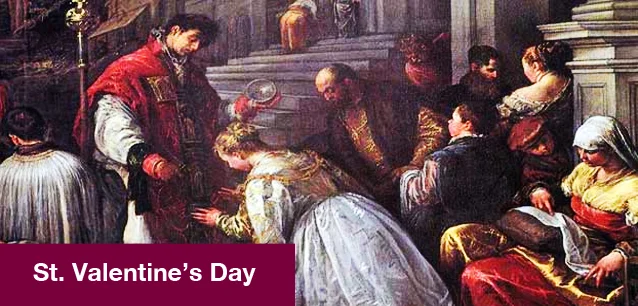 AD
AD
Today is: November 05
Scroll to explore events active on this date.
Additional Events on LEEP
LEEP INK FEATURES

August? Absolutely!
In August, we live through the Dog Days of Summer. It's hot and often humid, and those who can leave for better climates do. Down south, winter is in full force. August is also known as "the ...

In The Heat of July: July 2025 Events
Is it hot enough (or cold enough if you're below the equator) for you yet? There is actually a day for that! Like every month, I pick a diverse collection of events you may or may not know about. This ...

May Blooms: Events in May 2025
Along with October, May is one of the most densely packed months of the year. It's before the summer humidity and the last whole month of the school year. The weather is warming in t...
About Valentine's Day
Christian
Ends: Feb 14, 2020
DESCRIPTION:
Saint Valentines Day commemorates the work of Bishop Valentine, who died in 269 AD. At that time, Christianity was not a major faith, (that changes in 361 AD) and the Roman Empire ruled 1/4 of the world’s population.
The Roman’s decided married men did not make good soldiers because they always wanted to return to their families. Their solution? Outlaw marriage.
Bishop Valentine was imprisoned for performing marriages. Couples used to pass notes through his cell window (why we send Valentines) and he’d marry them in secret. Eventually, Emperor Claudius ordered Bishop Valentine executed for his part in illegally marrying men and women. However, the order was primarily because the bishop tried to convert the emperor to Christianity.
In 496 AD Pope Gelasius declared February 14th as St. Valentine’s Day to honor the anniversary of Bishop Valentine’s martyrdom.
St. Valentine is the Patron Saint of affianced couples, bee keepers, engaged couples, epilepsy, fainting, greetings, happy marriages, love, lovers, plague, travelers and young people.
Origins and Meaning of Valentine's Day
by Lorne Caplan, for Couples Company,
Living in North America, we tend not to pay too much attention to the marketing machines that are constantly telling us to buy this or that. At least we're not completely aware of it. However, subliminally, we are overwhelmed by efforts to extract our hard earned cash on synthetic holidays, like Valentine's Day.
That isn't to say some of these "Hallmark Holidays" can't be ideal opportunities to reconnect with people that we care about. It is just that we have allowed others who have ulterior motives to tell us what to do and how to respond on events like Valentine's Day, which had dubious beginnings in human history to begin with.
Conflicting Origins of Valentine's Day -
What we are familiar with today, wasn't always how this event was celebrated. Instead of chocolates, flowers and gifts to share with our spouses, prospective dates (those we hope to make our sweethearts), girlfriends or boyfriends, in ancient Rome, disallowed marriages were performed in secret under the reign of Roman emperor Claudius II. It seems he didn't want single men getting married. They didn't make good soldiers and one priest, who didn't agree with the Emperor's decree (which always boded ill in those days, you just didn't disagree with an Emperor), performed marriages in secret. Alternatively, this same Valentinus may have instead been protecting early Christians as well as helping to feed and cloth jailed Christians, for which he would have also assuredly paid with his life.
Most people who defied those in power during Roman times, would usually be paraded about, tortured and starved before being publicly put to death. It was a kind of entertainment, not dissimilar to Roman gladiators slaying each-other for sport. So legend has it that this erstwhile priest sent a message from his dungeon cell (jail cell suggests some humanity and It's unlikely there was any afforded this supporter of young love and the downtrodden) to his jailers daughter, whom he fell in love with. It is said that she showed him kindness and visited him during his incarceration. This letter of affection was signed "Valentine" and thus, the legend had a martyr, a story of blossoming love and a villain of course, who's irrational and evil plans to squash romance, love and passion was overcome in death. Sounds like a Disney cartoon doesn't it?
It is variously agreed, that Valentine was made a Saint for his death on around 270 BC, which was then commemorated in February, to celebrate his support and good deeds for singles and Christians.
A more likely scenario has Valentine's origins as an effort to convert the debauchery, physicality and essentially, rampant copulation during the festival and feast of Lupercalia into a Christian holy day. You see, this was a fractious period in human history, where pagans and Christians were at war to dominate civilization. Lupercalia was a springtime celebration of renewal and a time of purification, which was a good idea when ancient Rome was so in need of cleansing with open sewers and so many other aspects of a rank and putrid society that most modern people can hardly even consider.
This cleansing began at the Ides of February (the 15th) and continued for a brief amount of time thereafter, but not before a goat or sheep was ritually slaughtered at the mouth of the cave to which the founders of Rome, Romulus and Remus, were thought to be cared for by a she wolf. The festival and offerings were also dedicated to Faunus, The Roman god of agriculture. Do you see how this festival can be co-opted to become, conveniently, a holiday for a new religion as most ancient pagan rituals were?
The Luperci, an ancient order of priests, led this ritual festival and therefore preserved their role in their society, provided their followers with an event to celebrate as well as keep masses under control and subservience. To make this event even more involved, young boys were said to take strips of the slaughtered animal and slap the blood soaked meat on crops and women to promote fertility. Yum! Not quite as endearing as a box of decadent chocolates is it?
Practices got a little more merry as time dragged on and by the beginning of the Christian era, young women would place their names in an urn, to which bachelors of any age, would pick and become paired with that women for the year. This pairing often ended in marriage and certainly after some, or rather a lot of, carnal activity went on. This tradition went even further by the middle-ages, when young men and women pinned names to their sleeves for a week to ward off would be suitors, while they secluded themselves with the woman they chose. This is where the expression "wearing your heart on your sleeve" came from and no, it wasn't at all gender equivalent. Sorry ladies. We men didn't "get it" until much, much later!
Needless to say, this fun (it wasn't always a match made in goat meat heaven) was banned as the Christian church became more powerful in the waning years of the Roman empire. In 498 C.E., Pope Gelasius declared February 14, St. Valentine's Day. The lottery pairing was banned as un-Christian, however the celebrations of renewal and coupling were maintained through to the middle-ages. This "fear" of Valentine's Day continues today, with the Iranian government and theocracy banning anything related to Valentine's Day.
Getting back to the history, with the ascendency of Gaul (modern day France), Spain and England as Christian powers, these countries inserted the realities of bird's mating seasons being in the middle of February, further solidifying the perception that Valentine's Day was a celebration of coupling and fertility. The ancient worship of mother earth and Druidism (which died out around the same time as Pope Gelasius attempted to quash another fun human activity) practiced by the ancient Celts, was also rolled into modern St. Valentine's celebrations, by combining the fertilization of the earth by the great father that occurred around the Spring solstice in March.
The Renaissance Romance
With wars raging for control of precious metal and the modern world, it was inevitable that some stories of love and romance should permeate the desperation and futile existence of whole populations caught up in this struggle. Apparently, it was the Duke of Orleans, Charles, who sent a "greeting" to his wife from his prison cell in the Tower of London. You see, he was captured during the battle of Agincourt, and in 1415 (when it was dated), he was trying to get word out of his and France's predicament in a carefully worded letter. This is considered the oldest Valentine "card" in existence, which was followed up by the English king Henry V, who hired a writer to send a Valentine's note to Catherine of Valois.
Some attribute the flourishing of Valentine's affection to the father of British literature, Geoffrey Chaucer who died in 1400 AD. He recorded the detailed rituals and mating habits of birds, to the amusement of the royal courts. Ultimately, British King Henry VII declared February 14 as Saint Valentine's Day, formally ensconcing it into our modern year calendar.
This constant fighting between to intractable and intertwined enemies would go on for centuries more, but the holiday, if you can call it that, had made it's mark and was further institutionalized in Britain by the middle of the 17th century with the proliferation of the printing press (invented in the middle of the 15th century). This allowed more people to hear authors like Chaucer through the Town Crier. Not only did most people not read, they also couldn't write for the most part, which is why most hand-written cards were completed by scribes and signed by the one sending the card and signed by an "x", which is where "x" gained it's image as an expression of love and a kiss.
While printed notes were still far too expensive for the masses, most people sent written notes to their partners through the middle of the 18th century. With the industrial revolution, it became affordable to buy pre-printed cards and send them.
In 1797, a primer for men called "The Young Man's Valentine's Writer" was published, to help the linguistically challenged. Versus and poems were provided by this primer and printed on cards that could be sent anonymously, with racy text that would otherwise be frowned upon during the prudishness of the era. Most cards, however, were still handmade, representing a higher station in life and an ability to provide for the chosen Valentine.
Americans too, began to send printed cards as postage rates became more affordable and by 1840, a woman named Esther Howland, created the first mass produced Valentine's Day cards. It is believed her desire to help women gain appreciation for their hard work and foster commitment from men to join with women in marriage.
The Age of Consumerism
The National retail Federation projected that consumers will spend over $18 billion dollars on Valentines Day in 2017. Cards, flowers, chocolates and jewelry are the most popular gifts. The first Hallmark Valentine's Day card was printed in only 1913.
A legend ties the first flowers given on Valentine's Day as those chosen by a French princess. She gave them to him on Valentine's Day during a party in his honor. This 17th century gift, was unattainable to the vast majority of people due to it's cost and rarity. As a symbol of love, the red rose was often chosen in the Victorian era, when Dutch flower distribution improved to the point that this sentiment could reflect the favorite flower of Venus, the Roman goddess of love. Richard Cadbury, in 1868, put his confections in a heart shaped box and gave it to his daughter. He denied that it had anything to do with the holiday, but those who could afford such luxuries started to adopt it as a ritual along with hand-written and printed cards.
Despite the value of the holiday today, it was not until after the Second World War and the boom in the economy, that small gifts were regularly exchanged along with cards. Today, 75% of all chocolate is purchased by men for Valentine's Day; women buy the majority of chocolate throughout the year.
Men tend to purchases lingerie, flowers and chocolate within two days of February 14th; women begin buying their special someone a gift by January 15th, a full month in advance of the holiday. Women also tend to take care of themselves too. Almost 15% of women buy themselves flowers on Valentine's Day.
During the 1980's, DeBeer's, the South African diamond conglomerate, saw an opportunity to extract some revenue from an increasingly wealthy North American population by marketing diamonds and jewelry as a Valentine's Day gift option. The campaign was highly successful.
With over a billion dollars in chocolate sold for the holiday and over 110 million red roses sold within three days of February 14th, you can see why it has become an important event during the calendar year for retailers.
VIDEOS
SUPPORTING DOCUMENTS
Currently, this event does not have supporting documents.
ADDITIONAL IMAGES
Currently, this event does not have supporting images.
Where would you like to go now?
LAST UPDATED:
Jul 18, 2022EVENT MANAGER:
Currently, this event does not have any manager yet. AD
AD


/footer-logo.svg)
